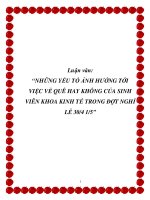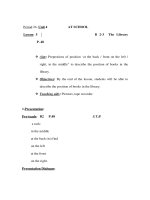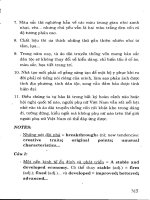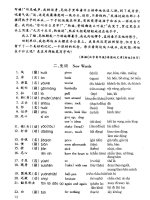4 1 5 this land is our land
Bạn đang xem bản rút gọn của tài liệu. Xem và tải ngay bản đầy đủ của tài liệu tại đây (3.38 MB, 10 trang )
Suggested levels for Guided Reading, DRA,™
Lexile,® and Reading Recovery™ are provided
in the Pearson Scott Foresman Leveling Guide.
Genre
Expository
nonfiction
Comprehension
Skills and Strategy
• Main Idea and
Details
• Generalize
• Graphic Organizers
Text Features
•
•
•
•
Heads
Captions
Time Line
Glossary
Scott Foresman Reading Street 4.1.5
ISBN 0-328-13424-4
ì<(sk$m)=bdeced< +^-Ä-U-Ä-U
by Johanna Biviano
Reader Response
1. Reread the section headings in this book. What
is a main idea in the book? Make sure to give
examples to support your answer.
2. Choose three dates from the time line on
page 7. Make a time line similar to the one
below with the dates you have chosen. Tell what
happened on each date.
Date
3. Look in the Glossary. On a separate piece of
paper, write the word with the suffix –ive. Write
the word with the suffix –ist. Use each word in a
complete sentence.
4. What can the time line on page 7 tell you about
national parks?
by Johanna Biviano
Editorial Offices: Glenview, Illinois • Parsippany, New Jersey • New York, New York
Sales Offices: Needham, Massachusetts • Duluth, Georgia • Glenview, Illinois
Coppell, Texas • Ontario, California • Mesa, Arizona
Our National Parks
America’s national parks have some of the most
impressive plants, animals, and land in nature.
Suppose you are flying in a plane over these parks.
Look out the window. You can see great forests,
crystal rivers, flocks of birds, and herds of animals.
The National Park Service was established to
preserve this wilderness.
Wapati elks lie in the
tall grass in Yellowstone
National Park.
Every effort has been made to secure permission and provide appropriate credit for
photographic material. The publisher deeply regrets any omission and pledges to
correct errors called to its attention in subsequent editions.
Unless otherwise acknowledged, all photographs are the property of Scott Foresman,
a division of Pearson Education.
Photo locators denoted as follows: Top (T), Center (C), Bottom (B), Left (L), Right (R),
Background (Bkgd)
Opener: Getty Images; 1 Corbis; 4 Creatas; 5 Getty Images; 6 Getty Images; 8 Digital
Vision; 9 Corbis, Peter Arnold; 10 Corbis/Richard T. Nowitz, Corbis/Dave G. Houser,
Stock Imagery; 11 Photo Researchers; 12 Getty Images; 13 Corbis, Getty Images;
14 Brand X Pictures, Getty Images; 15 Digital Stock, Getty Images
ISBN: 0-328-13424-4
Copyright © Pearson Education, Inc.
All Rights Reserved. Printed in the United States of America. This publication is
protected by Copyright, and permission should be obtained from the publisher
prior to any prohibited reproduction, storage in a retrieval system, or transmission
in any form by any means, electronic, mechanical, photocopying, recording, or
likewise. For information regarding permission(s), write to: Permissions Department,
Scott Foresman, 1900 East Lake Avenue, Glenview, Illinois 60025.
2 3 4 5 6 7 8 9 10 V0G1 14 13 12 11 10 09 08 07 06 05
3
George Catlin, a famous artist, traveled through
America in 1832. He saw great valleys and rivers.
He saw buffalo herds roaming the plains. He learned
about Native American life and about all the different
people he met.
George Catlin worried that people coming
to settle the wild lands would use it all up. He
wondered how to preserve the land and the species,
or kinds of plants and animals, on it. He hoped
that people would want to protect nature.
The government felt the same as George Catlin
did. It wanted to make parks out of the natural
wonders in America. Lawmakers decided to create
a park where the Yellowstone River flowed, through
parts of what we now call Montana, Wyoming,
and Idaho. In 1872 Yellowstone became the first
national park.
Yellowstone National Park
A herd of bison grazing in the
Theodore Roosevelt National
Park in North Dakota
4
5
Historical Sites
The United States also wanted to preserve places
that are important in our history. Some sites of
prehistoric ruins became parks around 1900. Mesa
Verde National Park in Colorado is filled with the
ruins of cliff dwellings, or homes, of the ancient
Pueblo people.
Cliff dwellings of Mesa
Verde in Colorado
Some parks, such as the Grand Canyon in
Arizona, were meant to be used for scientific
learning. Scientists and other visitors can study the
natural wonders of these parks.
In the eastern United States, there were not
many national parks. Then the National Park Service
created monuments at famous historical places.
These national monuments preserve birthplaces
of presidents, and battlefields and cemeteries from
American wars.
National Parks
1872
Yellowstone National Park
(Montana, Wyoming, and Idaho)
1890
Yosemite Valley National Park
(California)
1908
Grand Canyon National
Monument (Arizona)
1916
Abraham Lincoln Birthplace
National Historic Site (Kentucky)
1936
Colonial National Historical Park
(Virginia)
1980
Women’s Rights National
Historical Park (New York)
Yosemite Valley
National Park in
California
6
7
Landscapes and Wildlife
Mount McKinley is in Denali National Park, in
Alaska. Mount McKinley stands 20,320 feet above
sea level. It is the tallest mountain in North America.
Six million acres of land make up Denali National
Park. Many different kinds of plants and animals live
on its mountain slopes. The plants in Denali have
to be tough. Most of the ground under the top layer
of soil stays frozen.
Mount McKinley in Alaska
Grizzly bear
8
The animals in Denali have to be strong too. Only
a small number of Denali’s birds can stay through
the harsh, long winters. Most of Denali’s birds
migrate south for the winter. They then return for
the short summer season. They depend on Denali’s
lakes, rivers, streams, and ponds. Glaciers from ten
thousand years ago made these bodies of water.
Wildlife in Denali
National Park
Caribou
9
Another Historical Park
The Colonial National Historical Park in Virginia
shows us how America looked to the first English
settlers. Like Denali National Park, this park is full
of impressive animals. Some of these animals are
endangered. There are also acres of protected land.
Jamestown’s “Old Towne” is located in the
Colonial National Historical Park. Old Towne
preserves the site of the first English settlement at
Jamestown, founded in 1607.
In Old Towne, guides wear clothes like those of
the first settlers. Visitors can learn about the life of
Pocahontas, a famous Powhatan woman. Pocahontas
helped settlers and Native Americans communicate.
Visitors can also see a statue of Captain John Smith,
who led the settlers in building the Jamestown
Settlement. You can relive history at the Colonial
National Historical Park.
You can visit the re-creation of the
original Jamestown settlement.
Guides dress in colonial
costume at Old Towne.
10
11
Preserving Wildlife
What does it mean to create a national park?
When the United States chose the land for the
first parks, there were no fences, no roads, no
bathrooms, and no guides! Who would take care
of the parks and make them easy to visit?
The U.S. Army was in charge in the 1890s. They
made roads and buildings. They guarded the parks
from hunters and loggers. They allowed people to
visit the parks to learn about the wildlife. In 1916 the
National Park Service was formed to run the parks.
Roads and buildings in the parks were improved in
the 1930s, and new parks were made.
Most national parks
have park rangers
to answer questions
visitors might have.
The Civilian
Conservation Corps at
work (below) and the
corps’ badge (left)
12
13
As soon as the first national park was created,
people began to argue about how to use the parks.
Should we let naturalists study the animals and
plants? Should we use the rivers to water the
farms nearby? Should we dig for oil? Should
builders use the wood from the forests?
All of these questions now have answers. In
national parks we preserve nature. We do not cut
down the wood for lumber. We do not use the water
for farming. All of the animals that live in the parks
are kept safe from hunters. We protect the historical
sites and the natural wonders of the wilderness, just
as George Catlin hoped that we would!
It is important to protect
our natural wildlife.
Pika
Ibis
Wolf
14
15
Glossary
glaciers n. great
masses of ice moving
very slowly down a
mountain, along a
valley, or over a land
area.
impressive adj. able to
have a strong effect on
the mind or feelings;
able to influence deeply.
naturalists n. people
who make a study of
living things.
preserve v. to keep
from harm or change;
keep safe; protect.
Reader Response
slopes n. lines, surfaces,
land, etc., that go up or
down at an angle.
1. Reread the section headings in this book. What
is a main idea in the book? Make sure to give
examples to support your answer.
species n. a set of
related living things
that all have certain
characteristics.
2. Choose three dates from the time line on
page 7. Make a time line similar to the one
below with the dates you have chosen. Tell what
happened on each date.
wilderness n. a wild
uncultivated region with
few or no people living
in it.
Date
3. Look in the Glossary. On a separate piece of
paper, write the word with the suffix –ive. Write
the word with the suffix –ist. Use each word in a
complete sentence.
4. What can the time line on page 7 tell you about
national parks?
16









